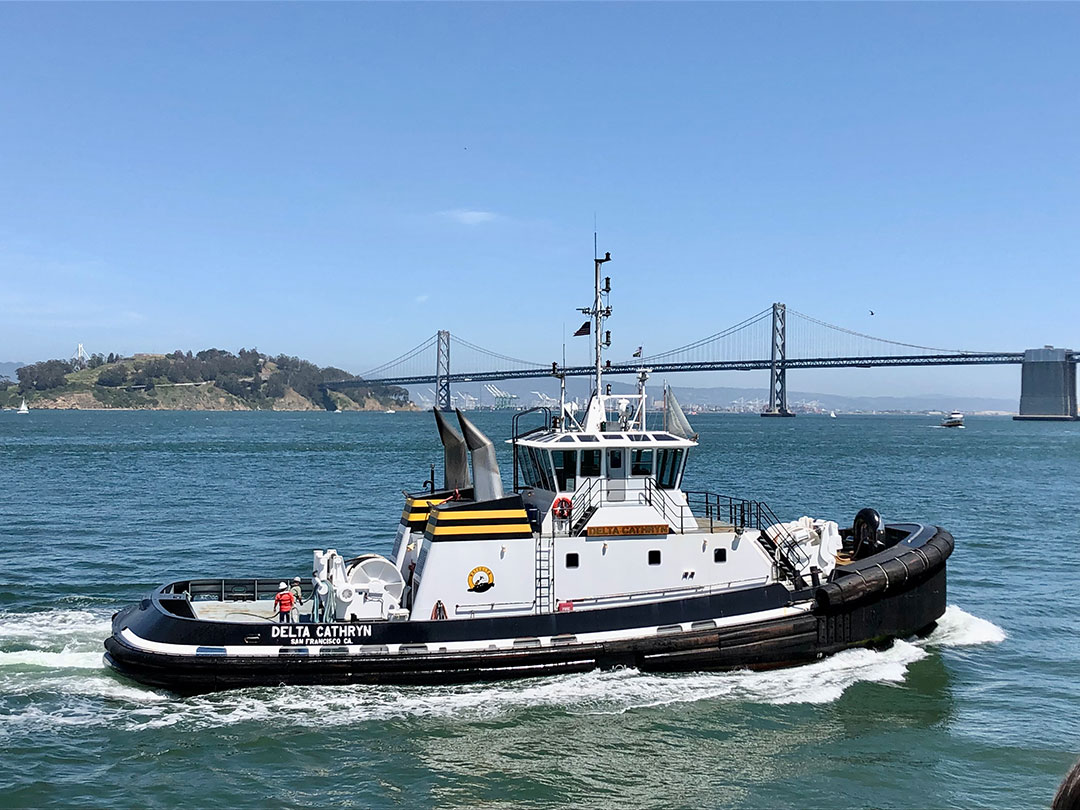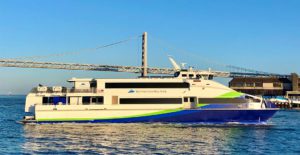
The California Air Resources Board (CARB) has enacted new emissions rules covering tugboats, ferries and other “commercial harbor craft” aimed at reducing air pollution.
The rules, which CARB approved in late March, amend emissions laws in effect since 2009. The new standards mandate that most tugboat and workboat operators in California transition to EPA Tier 3 and Tier 4 engines. These engines also must be equipped with diesel particulate filters (DPFs) that capture more particulate matter than is required by the federal Environmental Protection Agency.

The new requirements also cover traditional ferries that transit more than 3 miles. All short-run ferries must transition to full zero-emission propulsion, and new excursion boats must generate at least 30 percent of their power from zero-emission sources.
The deadlines in place for the tug and ferry industries vary by the age of the engine. Extensions are available in some cases that would let operators delay the upgrades.
Crowley Maritime, which was founded in San Francisco Bay more than a century ago and maintains a large presence in the state, opposes the new rules. It says the changes will force the company’s articulated tug-barges (ATBs) to leave the California market by 2024 and contribute to higher gas prices for consumers.
“While we share CARB’s goal of reducing emissions, we are disappointed in (the) regulation amendments recently approved,” Crowley spokeswoman Torey Vogel said. “The amendments show a deliberate disregard for the operational nature and federally defined distinction of ATBs as seagoing vessels rather than ‘harbor craft.’
“By adopting these amendments,” she continued, “CARB is setting unrealistic requirements that will result in adverse effects for California’s consumers and businesses.”
The new measures come as amendments to rules CARB has had in place since 2009 that mandated operators transition from older, dirtier-running engines to those that meet at least EPA Tier 2 standards. The new rules amend those standards, requiring vessels to install Tier 3 or Tier 4 engines by 2035 — or in many cases sooner.
The first deadlines impact previously unregulated vessels that have Tier 1 and older engines. Those vessels must start meeting the new CARB rules starting Dec. 31, 2023, with the phase-in period continuing through Dec. 31, 2025. Engines installed in 2020-21 have as late as until 2031 to comply.
The first deadline to meet a performance standard equivalent to Tier 4 engines plus a DPF is Dec. 31, 2024. Extensions are available if no DPFs become verified before compliance dates or if there are issues pairing the units with engines, among other scenarios.
These rules will apply to roughly 225 tugs and towboats operating in California, and about 70 ferries. They also cover dredges, ATB tugs, pilot boats, commercial fishing boats and sport-fishing boats operating within the state. Tier 3 engines with a DPF will satisfy the rules if no Tier 4 engine is available for engines rated below 600 kW, or about 803 hp.
Industry groups have raised numerous concerns about the changes. Lynn Muench, senior vice president for regional advocacy for the American Waterways Operators (AWO), cited practical and logistical issues that could prevent some operators from complying.
For one thing, she said, there are currently no DPFs on the market that will fit onto marine engines for use on commercial harbor craft. Swapping older engines for newer compliant models will require engineering work and could create stability challenges. Older tugs designed well before Tier 4 took effect also might not have enough space to fit aftertreatment systems and tankage for diesel exhaust fluid (DEF).
“And if you talk to any shipyards, there are not a lot of empty dry docks around to do all this work,” Muench said.
The Passenger Vessel Association (PVA), a trade group representing ferry and excursion boat operators, voiced similar concerns. It predicts “significant challenges ahead” for the passenger vessel industry in California.
“EPA-certified Tier 4 engines are not likely to be available for smaller passenger vessels,” said Eric Christensen, director of regulatory affairs and risk management for the PVA. “Shoreside charging infrastructure for battery-powered vessels does not exist in most places. No-emission propulsion technologies, such as hydrogen fuel cells, are beyond the financial reach of private operators.
“And California’s existing incentive measures, such as the Carl Moyer grant program, do not offer sufficient funding to overcome these barriers,” he continued. “Nevertheless, PVA members in the state will do their utmost to make their ‘green’ fleets even ‘greener.’”
Seamus Murphy, executive director of Water Emergency Transportation Authority (WETA) and San Francisco Bay Ferry, said the operator already runs the cleanest high-speed ferries in the nation for its San Francisco Bay service. Meeting the new rules will come at a cost.
“We’ve worked closely with CARB to design a path forward that accelerates zero-emission adoption on our core routes and moves carbon-free marine propulsion technology further along faster,” he said by email. “We’re confident that CARB understands our critical transition to zero-emission ferries will require substantial public investment, including from the state.”
CARB said the new rules will have a noticeable effect on emissions and public health. By 2035, particulate matter generated by commercial harbor craft will fall by 89 percent, and nitrogen oxide (NOx) emissions will fall by 54 percent. Greenhouse gas emissions will fall by 415,000 metric tons cumulatively between 2023 and 2038.
The state projects those reductions will prevent 531 premature deaths, 161 hospital admissions and 236 emergency room visits, “providing $5.25 billion in benefits versus $1.98 billion in costs.” Industry groups have raised questions about this data.
CARB acknowledges the costs of the upgrades ultimately will be passed along to consumers. It projects the cost of a typical ferry trip would rise by about $2 per person, each way, while the cost of moving a 20-foot shipping container would rise by 48 cents. Seafood would rise in price by 4 cents per pound, while a single-day sportfishing charter would rise by about $40 per person.
Industry groups like the AWO and PVA argue that costs will fall, at least initially, upon operators who in many cases have limited ability to raise their rates to pay for new engines, let alone the engineering work needed to install them. The AWO met with CARB officials many times to request changes to the rules, including allowing operators to use their engines through their useful life, Muench said. That request was not granted.
She expects the cost of complying will put some maritime companies out of business. Others will reduce their fleet sizes or leave the California market altogether. “How do you replace an engine or build a whole new vessel 10 to 15 years earlier than you normally would?” Muench said.
Industry groups will continue to make their case to California officials, including lawmakers, in hopes of achieving minor concessions, such as a delay for some provisions. Muench was not optimistic but added, “hope springs eternal.”
